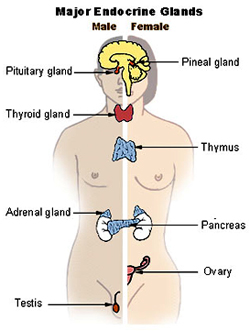Hormones
Sakshi Education

A gland is an Organ that consists of Cells that Secrete materials into other regions of the Body.
The body contains two types of Glands:
A. Exocrine Glands: Secrete Nonhormonal Chemicals into Ducts, which transport the Chemicals to a Specific Location inside and outside the Body. Sweat Glands, Mucous Glands, Salivary Glands, and other Digestive Glands are Examples of Exocrine Glands.
B. Endocrine Glands - are Ductless Glands that are located throughout the body. Endocrine Glands Secrete Hormones into the Bloodstream through the fluid that surrounds their Cells.
Exocrine Glands: secrete their products via a duct; the glands in this group can be divided into three groups:
Various organs throughout the body are sources of Hormones. Organs that produce Hormones are called Endocrine glands and form the Endocrine system. Some other Organs not considered Glands produce Hormones. The Brain and Kidney are two other organs that also produce Hormones. Endocrine Glands Secret Hormones Directly into the Bloodstream – Ductless Glands.
The Hormones travel to a Specific Tissue or Organ called target cells. At the Target Cells, Hormones elicit a Specific Response. Hormones are essential to maintaining Homeostasis. The Endocrine system works Hand - in - Hand with the Nervous System to:
The Hypothalamus:
B. Oxytocin – Stimulates Contractions of the Uterus during Labor, also causes the release of milk from the breast of a nursing mother.
Anterior Pituitary Gland:
The body contains two types of Glands:
A. Exocrine Glands: Secrete Nonhormonal Chemicals into Ducts, which transport the Chemicals to a Specific Location inside and outside the Body. Sweat Glands, Mucous Glands, Salivary Glands, and other Digestive Glands are Examples of Exocrine Glands.
B. Endocrine Glands - are Ductless Glands that are located throughout the body. Endocrine Glands Secrete Hormones into the Bloodstream through the fluid that surrounds their Cells.
Exocrine Glands: secrete their products via a duct; the glands in this group can be divided into three groups:
- Apocrine glands - a portion of the secreting cell's body is lost during secretion. Apocrine gland is often used to refer to the apocrine sweat glands. Eg: the lactating mammary gland, cerumen ("wax") of the outer ear
- Holocrine glands - the entire cell disintegrates to secrete its substances (e.g., sebaceous glands)
- Merocrine glands - cells secrete their substances by exocytosis (e.g., mucous and serous glands). Also called "eccrine."
- Serous Glands- secrete a watery, often protein-rich product. In physiology, the term serous fluid is used for various bodily fluids that are typically pale yellow and transparent, and of a benign nature. Saliva consists of mucus and serous fluid; the serous fluid contains the enzyme amylase important for the digestion of carbohydrates. Another type of serous fluid is secreted by the serous membranes (or serosa), two layered membranes which line the body cavities. The serous fluid between the two layers acts as a lubricant and reduces friction from muscle movement. A common trait of serous fluids is the ease in their role in assisting bodies in digestion, excretion, and respiration.
- Mucous Glands- secrete a viscous product, rich in carbohydrates (e.g., glycoproteins) Mucus is a slippery secretion of the lining of various membranes in the body (mucous membranes). It is a viscous colloid containing antiseptic enzymes (such as lysozyme) and immunoglobulins. Mucus is produced by goblet cells in the mucous membranes that cover the surfaces of the membranes. It is made up of mucins (Mucin genes encode mucin monomers that are synthesized as rod-shape apomucin cores that are post-translationally modified by exceptionally abundant glycosylation. The dense "sugar coating" of mucins gives them considerable water-holding capacity and also makes them resistant to proteolysis, which may be important in maintaining mucosal barriers) and inorganic salts suspended in water. Phlegm is a type of mucus that is restricted to the respiratory tract, while the term mucus refers to secretions of the nasal passages as well.
- Sebaceous Glands- secretes a lipid product. The sebaceous glands are glands found in the skin of mammals. Sebaceous glands secrete an oily substance called sebum (Latin, meaning fat or tallow) that is made of fat (lipids) and the debris of dead fat-producing cells. In the glands, sebum is produced within specialized cells and is released as these cells burst; sebaceous glands are thus classified as holocrine glands. Sebum is odorless, but its bacterial breakdown can produce odors. Sebum is the cause of some people experiencing "oily" hair if it is not washed for several days. Earwax is partly sebum. Function: Sebum acts to protect and waterproof hair and skin, and keep them from becoming dry, brittle, and cracked. It can also inhibit the growth of microorganisms on skin.
Various organs throughout the body are sources of Hormones. Organs that produce Hormones are called Endocrine glands and form the Endocrine system. Some other Organs not considered Glands produce Hormones. The Brain and Kidney are two other organs that also produce Hormones. Endocrine Glands Secret Hormones Directly into the Bloodstream – Ductless Glands.
The Hormones travel to a Specific Tissue or Organ called target cells. At the Target Cells, Hormones elicit a Specific Response. Hormones are essential to maintaining Homeostasis. The Endocrine system works Hand - in - Hand with the Nervous System to:
- Maintain the body's internal steady state - Homeostasis (nutrition, metabolism, excretion, water and salt balances).
- React to stimuli from outside the body.
- Regulate growth, development and reproduction.
- Produce, use and store energy
- Nerve Impulses prompt a nearly instantaneous response to a change in the environment.
- Hormones on the other hand are Released More Slowly than nerve impulses, but their effects usually last Longer. Effects of some Hormones can last 10 to 20 minutes. Some Hormones can last for several hours.
- For many hormones, including most protein hormones, the receptor is embedded in the membrane on the surface of the cell. The interaction of the hormone and the receptor typically triggers a cascade of secondary effects within the cytoplasm of the cell, often involving phosphorylation or dephosphorylation of proteins, changes in ion channels, or increased amounts of an intracellular molecule that serves as a second messenger (e.g., cyclic AMP).
- The second common type of mechanism, typically involving smaller-sized hormones such as steroid or thyroid hormones, begins with entry of the hormone molecule into the cytoplasm of the cell where it combines with a loose and mobile receptor. The combined hormone-receptor ligand then moves across the nuclear membrane into the nucleus of the cell and binds to the DNA, effectively amplifying or suppressing the action of certain genes, thereby affecting protein synthesis.
- Amine-derived hormones are derivatives of the amino acids tyrosine and tryptophan. Examples are catecholamines and thyroxine.
- Peptide hormones consist of chains of amino acids. Examples of small peptide hormones are TRH and vasopressin. Peptides composed of scores or hundreds of amino acids are referred to as proteins. Examples of protein hormones include insulin and growth hormone. More complex protein hormones bear carbohydrate side chains and are called glycoprotein hormones. Luteinizing hormone, follicle-stimulating hormone and thyroid-stimulating hormone are glycoprotein hormones.
- Lipid and Phospholipid-derived Hormones – are derived from lipids such as linoleic acid and arachidonic acid and phospholipids. The main classes are the steroid hormones that derive from cholesterol and the eicosanoids. Examples of steroid hormones are testosterone and cortisol. Sterol hormones such as calcitriol are a homologous system. The adrenal cortex and the gonads are primary sources of steroid hormones. Examples of eicosanoids are the widely studied prostaglandins.
The Hypothalamus:
- The Hypothalamus is the part of the Brain and Nervous System that regulates body temperature, breathing, hunger and thirst. Located beneath the Thalamus in the Brain, it Regulates Our Body's Internal Environment.
- The Hypothalamus can also be considered the Master Switchboard for the Endocrine System. The Hypothalamus regulates the Two Lobes Pituitary Gland. By Releasing - Releasing or Releasing-Inhibiting Hormones.
- The Hypothalamus links the Nervous System to the Endocrine System.
- Neurosecretary cells of the Hypothalamus Produce hormones that either are stored in the Pituitary Gland or regulate the Pituitary's Activity.
- The Hypothalamus is continuously checking (monitoring) conditions inside your body.
- If your Internal Environment (Homeostasis) starts to get out of balance, The Hypothalamus has several ways to set things right again.
- Send out a Nerve Signal to another part of the Brain – the Medulla – to speed up or slow down your heart rate.
- Send out commands in the form of Hormones, thus acting like an Endocrine Gland.
- The hypothalamus and the Pituitary gland are the primary regulators of the Endocrine system.
- A small gland about 1 cm in diameter is connected to the Hypothalamus by a Stalk-like Structure.
- The Pituitary has two portions called the Posterior and the Anterior Pituitary.
- The Posterior Pituitary Stores Two Hormones, Vasopressin or ADH and Oxytocin, both, which are Produced By and Released from the Hypothalamus.
B. Oxytocin – Stimulates Contractions of the Uterus during Labor, also causes the release of milk from the breast of a nursing mother.
Anterior Pituitary Gland:
- Neurosecretory Cells in the hypothalamus also produce and secrete releaseing hormones, which stimulate Endocrine Cells of the Anterior Pituitary Lobe to produce and Secrete Hormones.
- Other Hypothalamic Cells which Produce release-inhibiting, which inhibit Production and Secretion of the Anterior Pituitary Hormones
- Releasing Hormones and Release-Inhibiting Hormones are produced in response to various stimuli that are processed by the Nervous system.
- There is at Least one Releasing Hormone for each Anterior Pituitary Hormone.
- The Anterior Pituitary produces at least 7 different Hormones:
A. Growth Hormone (GH) (Somatotropin) – Promotes cell division, protein synthesis, and Bone and Muscle Growth.
B. Prolactin (PRL) – It causes mammary gland in breast to develop and produce milk. It also plays a role in carbohydrate and fat metabolism.
C. Melanocyte-Stimulating Hormone - stimulates the Melanocytes of the Skin, increasing their production of the dark pigment melanin.
- The Anterior Pituitary (Hypophysis) is sometimes called the Master Gland because it Controls the Secretion of other Endocrine Glands.
- The Anterior Pituitary Secretes the following Hormones, which have an Affects on other Endocrine Glands:
A. Thyroid-Stimulating Hormone (TSH) – Regulates the Thyroid to Produce and Release Thyroxin and Triiodothyronine.
B. Adrenocorticotropic Hormone (ACTH) – Which stimulates the Adrenal Cortex. Causes the Adrenal Cortex to Produce and Release Cortisol and Aldosterone.
C. Gonadotropic Hormones (Follicle-Stimulating Hormone – FSH and Luteinizing Hormone - LH) - Which stimulate the gonads - the Testes in Males and the Ovaries in Females. Causes the Gonads to Secrete Sex Hormones and Stimulates Gamete (Sperm and Egg) Production.
- Located at the base of the neck just below the larynx.
- Thyroid-Stimulating Hormone (TSH) regultes the Thyroid Gland
- Produces Thyroxin, Triiodothyrosine and Calcitonin
A. Thyroxin & Triiodothyronine stimulates and maintains metabolic activities, normal heart rate, blood pressure, and body temperature. They also promote carbohydrate usage over fat usage for energy. Tyroxine acts as a morphogen by controlling the growth and differentiation of cells. For example, it has been identified as the hormone controlling metamorphosis of tadpoles to frogs (IISC 2007).
B. Calcitonin (C cells) inhibits release calcium from bones or regulates the level of calcium in the blood.
- In order to produce Thyroxin and Triidothyronine, the thyroid gland requires iodine. Iodized salt.
- Goiter the swelling of the thyroid gland is a result of Iodine deficiency.
- Decrease level of Thyroxine caused a decrease in the cellular respiration rate. Cells produce less energy and become less active.
- Hyperthyroidism – Too much Thyroxine results in nervousness, elevated body temperature, increased heart and metabolic rates, increased blood pressure, and weight loss. Hyperthyroidism can be treated with medication or by surgical removal of part of the Thyroid gland.
- Hypothyoidism – Not enough Thyroxin results in lower metabolic rate (Lethargy) and body temperature, lack of energy, and weight gain. In some cases, is associated with Goiter, or enlargment of thyroid gland. Hypothyroidism can be treated with supplementary Thyroxin.
- Hypothyroidism in infants affects normal development of the skeleton, muscular and nervous systems and results in a condition called Cretinism.
- Cretinism is characterized by Dwarfism and Mental Retardation.
- Attached to or embedded in the back surface of the thyroid gland, tow in each lobe.
- Produces Parathyroid Harmone (PTH) regulates the calcium levels in the blood by increasing the reabsorption of calcium in the kidneys and by increasing the uptake of calcium from the digestive system.
- Parathyroid Hormone is important in promoting proper nerve and muscle function as well as maintaining bone structure.
- Loss of parathyroid causes a drop in the level of calcium in the blood, which may result in violent muscular spasms known as Tetany.
- Can be relieved by the administration of large amounts of PTH and injections of calcium.
- One gland is located on top of the kidney.
- Compose of two very different types of tissues so it is divided into two parts.
A. Outer - The Adernal Cortex
B. Inner - The Adrenal Medulla
- The outer portion makes up 80 percent of the mass of the gland.
- The Adernal Cortex responds to Adrenocorticotropic hormone (ACTH), which is secreted by anterior pituitary gland.
- Produces more than two dozen hormones called Corticosteroids, which are steroids hormones and essential for normal body function.
- Aldosterone regulated the reabsorption of sodium and the excretion of potassium by the kidneys. This affects water and salt balance in the body.
- Cortisol affects carbohydrate, protein and fat metabolism. It also helps people cope with stress.
- Decrease activity of the Adrenal Cortex can result in Addison’s disease – Weight loss, low blood pressure, and general weakness, death may occur because of heart failure.
- People with Addisons disease receive regular doses of Adrenal cortical hormones.
- Increase activity of the Adrenal Cortex can result in Cushing Syndrome – Obesity, increase blood sugar levels, high blood pressure, and weakening of bones.
- Treatment involves decreasing the secretion of hyperactive hormone, if possible.
- The inner portion is a specialized part of the sympathetic nervous system.
- Secrets two acid hormones called Neurohormones – Adrenaline (Epinephrine) and Noradrenaline (Norepinephrine).
- Adrenaline is more powerful in its actions and makes up 80 percent of total secretions.
- "Fight or Flight Hormones – Nerve impulses form the sympathetic nervous system results in the secretion of Adrenaline and Noradrenaline.
- Adrenaline increases heart rate, blood pressure, and blood supply to skeleton muscles, increases the conversion of glycogen to glucose and stimulates the rate of metabolism.
- Noradrenaline stimulates the heart muscle – increases rate and strength of heartbeat.
- Gonads – The ovaries in females and the testis in males – are gamete – producing organs that also produce a group of steroid sex hormones.
- Sex hormones regulate body changes that begin with puberty.
- Puberty is the adolescent stage during which the sex organs mature and secondary sex characteristics, such as facial hair, appear.
- When secreted by the Anterior Pituitary Gland, Luteinzing Hormone (LH) and Follicle-Stimulating Hormne (FSH) stimulate secretion of secretion of sex hormones from the gonads.
- The female gonads, or Ovaries produce eggs (Ova) and also produce sex hormones that affect cells throught the body.
- The Ovaries produce the female sex hormones, the Estrogens and Progesterone.
- Estrogens are required for the development of Ova and for the formation of physical characteristics (Secondary sex characteristics) associated with the female.
- These characteristics include the development of the female reproductive system, the mestrual cycle begins, widening of the hips and development of Breast. Puberty.
- Progestrone prepartes the Uterus for the arrival of a developing embryo – or controls the menstrual cycle.
- Male Gonads or Testis produce Sperm, and sex hormones that affect cells throught body.
- Testes produce Androgens or the male sex hormone Testosterone is an Androgen that regulates male secondary sex characteristics.
- Androgens are required for normal sperm production and the development of physical characteristics (secondary sex characteristics) associated with the male puberty
- These characteristics include the growth of facial hair, increase in body size and deepening of the voice.
- Locted just behind the stomach.
- Pancreas is both an exocrine (Ducts) and endocrine gland.
- The hormone producing portion of the parcreas consists of clusters of cells that resemble islands, called Islets of Langerhans.
- Each islet is composted of beta cells, which secrets insulin, and alpha cells which secrets Glucagon.
- These two hormones, insulin and Glucagon regulate the metabolism of blood glucose (sugar) and the hormones have opposite effects (Antagonistic Hormones).
- Insulin stimulates its target cells to take up and use glucose. This action lowers blood glucose levels. “Use or Store”.
- Glucogon stimulates its cells to breakdown stored glycogen and increase glucose levels in the blood.
- When there is an under secretion of Insulin, a condition called Diabetes Mellitus occurs.
- Type I or Juvenile Onset – Before age 25, little or no Insulin production requires a strict diet and daily injections of Insulin.
- Type II or Adult Onset – After age 40, produce normal amounts of Insulin, but cells are unable to respond properly because of lack of Insulin receptors, can be controlled by diet.
- Hypoglycemia Caused by excess (High) Insulin or low blood sugar, a Disorder in which glucose is stored rather than being properly delivered to the cells of the body – causing cells to starve to death. This leads a lower blood glucose concentration and subsequent release of Glucagon and Epinephrin (Adrenaline). Sympotoms of hypoglycemia include Lethargy, Dizziness, Nervousness, Overactivity, and in extreme cases, Unconsciousness (Ketoacidosis or Diabetic Coma) and Death. To assist someone with this problem, provide them some Sugar, such as Soda (6 oz).
- Hyperglycemia caused by low insulin or high blood sugar. Can cause Nausea and Rapid Breathing, possibly leading to Oxygen Deficiency, Circulatory and Nervous System Failure, Diabetic Coma, or even Death.
- The Thymus gland is located beneath the sternum (Breastbone) and between the lungs.
- The Thymus consists mostly of T-cells and plays a role in the development of the immune system.
- The Thymus gland secretes Thymosin, an aminoacid based hormone that stimulated the formation of T-cells, which help defend the from pathogens.
- The pineal gland located near the base of the brain.
- The Pineal gland secretes the hormone Melatonin.
- Melatonin concentrations increase sharply at night and decrease dramatically during the day.
- This cyclic release melatonin indicates that it helps regulate Sleep.
- Endocrine cells within the walls of some digestive organs also secrete a variety of hormones that help digest food.
- When food is eaten, endocrine cells in the stomach lining secrete Gastrin, a hormone that stimulates other stomach cells to release digestive enzymes and hydrochloric acid.
- Endocrine cells of the small intestine release Secretin, a hormone that stimulates the release of various digestive fluids form the pancreas and Bile from the liver.
Published date : 17 May 2014 04:00PM










